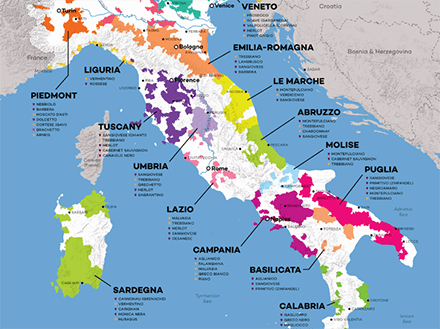Italian Wine
Italians are known for their wine and their pizza, and it is thus not a surprise that they lead when it comes to wine production. This country, being home to some of the oldest wine-producing areas, has come quite a long way in wine-making and is thus quite ahead of most regions in the world. As at now, it accounts for close to fifty million hl per year. The impressive thing about this volume is that it is a quarter of what the world consumes, thus putting Italy at the helm when it comes to production. Of course, this is not a difficult target to meet when all the regions in the country are under grape cultivation. With millions of vineyards in tow, how hard can it be to outrank all other countries in producing not only the most but also the best wines in the world?
How did it all come to be?
Vine cultivation began early in the Italian regions. However, at the time of inception, people did not put much thought into the practice, and for this reason, the cultivation was not intensive. Soon after the Greeks colonized Italy around 800 BC, they put a lot of effort into making vine cultivation productive. With this change, it became possible for more wine production.

More historical events such as the defeat of the Carthaginians by the Romans led to more wine production over the years. Through the use of slaves in the fields, vine growers were able to increase their capacity with each year. The increase in viticulture became so much that at one time an emperor called for the destruction of vines to create room for food production. They had taken up so much space for their grapes that they had forgotten that they still needed food at the end of the day.
The interesting thing was that all this time, only Italians could take part in viticulture as the practice of the same outside the region was illegal as per the Roman law. Provinces in need of wine paid for the same in the form of slaves and thus trades with Gaul (now France) became intensive. The latter region comprised people who appreciated excellent and unmixed wine which they drank without any restraint. Back then, people mixed their wine with water and not blending led to the consumption of large volumes of wine.
It was a while before laws as to viticulture relaxed. When other regions got the chance to grow vines, they took on the opportunity with zeal, leading to an increase in wine production across the globe. This spread in viticulture also led to the discovery of other grape varieties which thus increased the options on the market.
Wine-Growing Regions
The fascinating thing about the wine-growing areas in the country is that they are in the twenty administrative regions in the state. The sections differ as to the kinds of wine produced as they all have different climatic conditions and the focus on different grape varieties. If you can understand each area, then you would be in a position to understand the variations.
These regions include the Liguria, Piemonte, Aosta Valley, Marche, Lombardia, Toscana, Veneto, Trentino-Alto Adige, Emilia-Romagna, Friuli-Venezia Giulia, Sicily, Umbria, Calabria, Lazio, Puglia, Sardinia, Basilicata, Abruzzo, Campania, and Molise.
Each region boasts of a particular variety. Take Friuli-Venezia Giulia as an example. She produces white wines that are famous across the globe.

The Appellation System
This system refers to the classification of wines. The first of its kind in Italy took place in 1963. There were many alterations to the system following the first classification. As things stand at present, the classification system uses a modification made in 1992, which comprises four categories. It is important to note that these categories are in line with the wine regulations as per the European Union.

The first is the 'Vini' which states that wine production can take place at any place within the EU. The only label is as to the colour of the wine.
The second refers to varietal wines, and these should comprise at least eighty-five per cent of a grape variety with international recognition. It could also include more than one grape. These too can get produced anywhere within the EU.
The third is the 'Vini IGP' where the wines should come from a specific region in Italy. They should also get produced using grapes cultivated under strict practices.
The last classification is the Vini DOP where the wines should have been IGP for the previous five years. These wines are subject to much stricter wines than the latter option and are thus considered top of all the classifications.
It is important to note that there are other classifications under the main four. Italy indeed has a rich history in wine-making and a high-wine production volume to boot. To Italy!